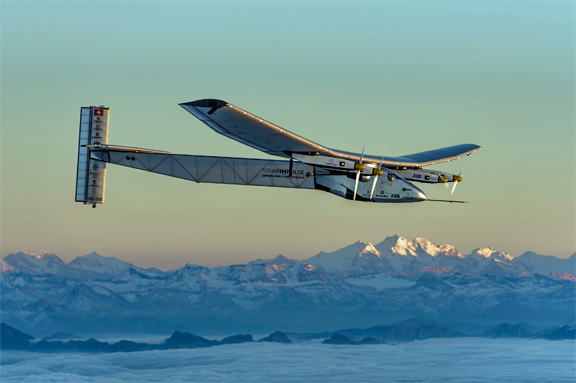[SatNews] A specially customized Cobham SATCOM AVIATOR 300SP (Special Purpose) system will provide data and voice connectivity for the revolutionary Solar Impulse (Si2) airplane when it takes off from Abu Dhabi on its historic global circumnavigation attempt.
Cobham has developed the lightest SwiftBroadband SATCOM terminal for the sun-powered aircraft, allowing access to Inmarsat’s SwiftBroadband service for the transfer of video, telephone and aircraft telemetry to the Solar Impulse mission control center. The Solar Impulse team and official national partner Swisscom integrated the equipment on the aircraft, with guidance about impact on system performance by different alternatives provided by Cobham.
The modified, 40 percent weight-reduced SBB system, including IGA-5006 antenna, Satellite Data Unit (SDU) and combined High Power Amplifier/Diplexer/Low Noise Amplifier (HLD), required Cobham, Inmarsat and Solar Impulse to agree minimum operating requirements, and commitment from Inmarsat to case approval. Providing a direct communication link between the pilot and the mission control center, the SATCOM system enables the transmission of weather updates and route planning, as well as coordination with air traffic control and technical backup. The Cobham system will provide the only link with the aircraft during the ocean crossings, when line-of-sight communications to the ground is not possible. In addition, the data link facilitates live television and internet streaming video coverage. Telemetry data will help the Solar Impulse ground team track the progress and monitor the health of the aircraft, as well as optimizing the energy management strategy.

From left to right: Cobham SDU, Cobham SATCOM IGA-5006 antenna and a Cobham standard HLD.
Photos courtesy of Cobham SATCOM.
Special modifications to reduce the weight of the system resulted in a total redesign of the SDU and customization of the electronics for the Solar Impulse mission. With only electric propulsion on the Si2 aircraft, the reduced vibration and temperature requirements allowed Cobham to save further weight. Special versions of the IGA-5006 antenna and the HLD were created by designing out excess structural metal and heat sink capacity. The position of the antenna on the airframe was another important aspect for consideration during integration of the SATCOM equipment to the aircraft systems. On the Si2 round-the-world aircraft, the antenna was placed on top of the tail fin which presents the least possible obstructions to the required clear line-of-sight to the satellites.
Johan Gericke, Director Systems Engineering, Cobham SATCOM, and the technical liaison to Solar Impulse, said, “The SATCOM AVIATOR 300SP system is the lightest SwiftBroadband SATCOM terminal by a large margin and was specifically developed for Solar Impulse to meet the prime weight criterion. Every gram of extra weight requires extra solar energy to raise the aircraft to the target altitude by the end of each flying day. While still employing established technology from the standard SDU, all superfluous interfaces and functions not required by the mission were eliminated. The resultant SDU is less than half the volume of the standard SDU and weighs in at less than a kilogram. Very early during the definition of the project, Cobham met with the Solar Impulse design team, the mission team, Swisscom, responsible for the end-to-end communication solution, and André Borschberg, the pilot and CEO of Solar Impulse. This allowed Cobham to accurately establish the mission profile and technical requirements before design and development work commenced. It is expected that the pilot will suffer from extreme fatigue during the longer hops of the round-the-world mission which will last for several days. The telephone connection offers a ground team as co-pilot. We wish them success.”
In addition to the SATCOM equipment, Cobham also provided a VT-2W high speed telemetry link, which was particularly important to verify design parameters during test flights. It is used primarily when the aircraft is within line-of-sight of a ground support team.
For more information, please visit http://www.cobham.com/satcom.



